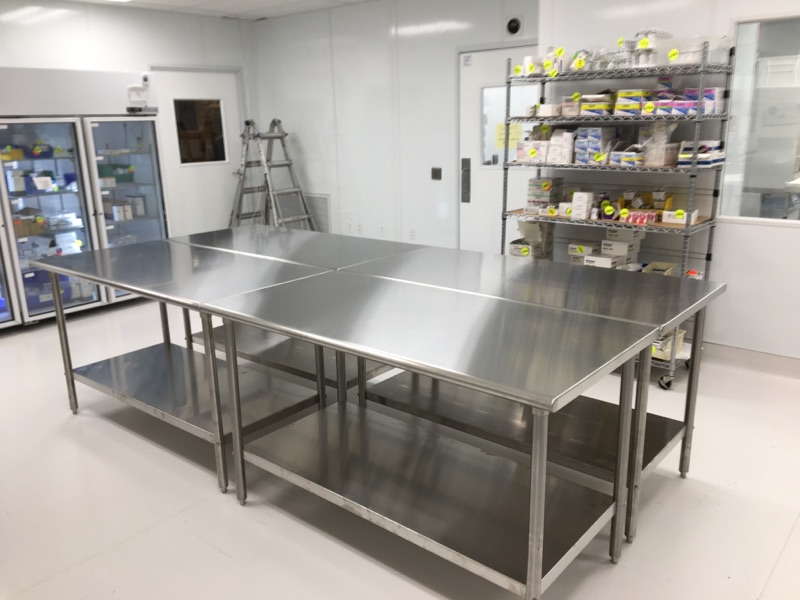From the layout of your cleanroom to the procedures you follow to keep it clean, every part of your cleanroom’s design is crucial to its function. This also includes the materials and furniture inside its walls that help you create or test your products.
Furniture inside a cleanroom serves many purposes. It not only provides spaces for you to develop your work or to support the equipment you use, it also provides comfort and support to your employees and controls excess movement that could be detrimental to your processes.
Too Much or Not Enough Cleanroom Furniture?
Generally, the fewer things in your cleanroom the better. Any furniture you use should be streamlined to maximize space and to allow for easy movement of people and air. That being said, you should have enough furniture to ensure your workers are comfortable and they have everything they need in the space to work effectively. Constant exiting and reentering of the cleanroom poses a higher risk of contamination than keeping a clean environment with all of the necessary materials already within the room.
Planning Your Cleanroom Furniture
When selecting cleanroom furniture, you’ll need to think about how many people you have working in the cleanroom at any given time who need tables to work at and places to sit. You’ll also need to keep in mind the ways your workers will interact with the furniture, pre-planning paths to doors, cabinets and counters. Every good cleanroom design will include a workflow around your furniture that is obvious and efficient.
The cleanroom furniture itself must comply with the needs of your work. It has to meet standards determined by your class type, be sturdy enough to hold any machinery or equipment you need and be able to withstand the chemicals you work with or use for cleaning.
The furniture you include might be specific to your application, but many types of furniture are needed by most cleanrooms: pieces like tables and chairs, countertops and cabinetry, shelves or other types of storage.
Surfaces and Work Areas
Almost every cleanroom will require a table or work surface for employees to use for note-taking, performing detailed work or to support equipment. Tables can either be fixed or moveable with casters. Depending on your cleanroom’s design, countertops may be the best work area because they double as storage, but they must be built into the cleanroom itself. Some cleanroom-specific furniture can be designed to be put away when not in use, which frees up a lot of open space in the room.
Chairs or Stools
When deciding on seating for your cleanroom, you’ll need to consider space as well as function. Stools take up less room, but chairs might provide more support and comfort to your workers if they have to remain at their stations for extended periods. Cleanroom seating should be ergonomic for workers as well as your space. Selecting adaptable furniture is a great choice because you can adjust settings to have the piece work for different employees or serve multiple purposes within your cleanroom. Multi-purpose furniture also cuts down on the amount of furniture you need to get the job done.
Storage Systems
Proper storage in a cleanroom is essential. Your cleanroom’s storage needs may differ if you must have special containers for cleaning supplies or hazardous materials. Having ample and accessible storage in place will help your cleanroom function effectively. Additionally, places to store materials and extra cleanroom furniture you don’t use all the time can help to keep your space clear of obstacles, which further maximizes the efficiency of your space.
Cabinets and shelves are great storage options that are easy to install and keep materials off the floor. They capitalize on vertical space and can help you keep your work areas clutter and contaminant-free.
Your Cleanroom Furniture Should Work For You
Knowing all of the pieces that need to come together within the cleanroom will affect the choices you make during its design. Your cleanroom furniture should enable your workers to be comfortable without getting in the way of important processes. Don’t forget to factor in furniture that supports your equipment such as fume hoods, gowning racks or HVAC vents. You should try to have a general idea of what furniture you’ll need prior to construction. Or, if you’re updating your current furniture, look at the space you’re using to determine how much and what kind of furniture works best.
Is it time to furnish your cleanroom, but you’re not sure where to start? As a cleanroom design, service, and installation company, we can help you choose the furniture that’s right for your classification and your budget. Reach out to Angstrom Technology to get started.


